I had a few false starts with this assignment, which ended up revealing to me some “data gaps”. I had initially gone to Facebook to get a copy of my data and activity from the last week. This would have included posts, photos and videos, comments, likes and reactions, friends, stories, messages, groups, events, pages, and so forth. Unfortunately however, I did not have much data from the past week. I did not realize how little I actually use Facebook. I am not active in any groups or pages and I don’t really look at what my friends post. I realized that I had thought I was a more active user simply because I use Facebook messenger. So my messages from the last week were available, but there was not much to look at because I had begun using other messaging apps.
I then checked my ad settings on my Google account to see what they thought I was interested in. I compared the ad settings of my personal account with my school account and found that they were very different. Even though I use my personal account more frequently, I felt that the personalized ads for my school account were actually a better fit. If you showed me both side by side I would think the school account was me, and the other was a different person. When I looked further into the reasoning behind each characteristic I found that on my personal account it was often because I had visited the advertisers site, while on my school account it was based on an aggregate of my searches and activity. Many of the sites that it listed I had visited on my personal account, I only recall visiting once or twice, and usually for a specific reason.
It was interesting to me that even though I had visited these specific advertiser’s sites I did not really identify with this “pixelated self” that Google made of me. On the other hand though, just by looking at an amalgamation of my search engine history and watch history on YouTube and comparing it to information they have on others with similar histories, Google was able to paint a picture of me that I felt was more accurate.
| School Account | Reason | Personal Account | Reason |
| Indie and Alt Music | search/history | Target | visited |
| Local News | search/history | Home Chef | visited |
| Comedy Films | search/history | YouTube | visited |
| Drama Films | search/history | P.F Chang’s | visited |
| Dogs | search/history | Dove | visited |
| Career Resources and Planning | search/history | Allure | visited |
| Books and Literature | search/history | Bloomberg L.P. | visited |
| Urban Transit | search/history | Coursera | visited |
| Not a Parent | search/history | Etsy | visited |
| Home improvement | search/history | 25-34 yo | info I gave |
| Homeowner | search/history | Female | info I gave |
| Single | search/history | Married | search/history |
| Household income: High | search/history | Household income: Upper middle | search/history |
I went to my screentime to see the apps that I was using, hopefully to lead me to a digital location (if that term makes sense) where I have more activity, and so more data. I realized that there is actually an app that I use very consistently to track personal data. I use a mood tracking app called Daily.io and am currently on a 51 day streak.
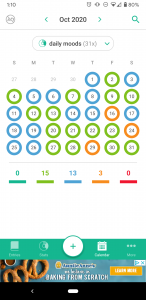
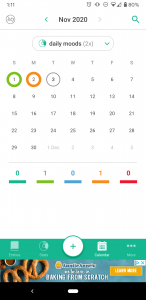
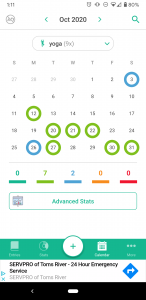
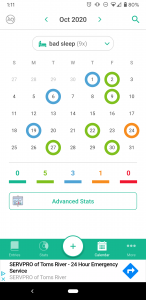
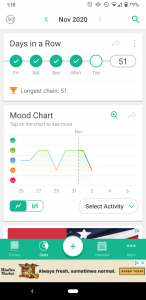
I appreciate how easily the app allows you to visualize the trends in your moods and frequency of activities that you track. The way that this app functions allows you to see potential correlations between different activities and your moods. This seems like an example of personal data collection and visualization that feels empowering as Boyd and Crawford discussed. I looked further into what the app states it does with the data. They claim that if you agreed to data collection they use Google Analytics to collect device IDs and usage information “in order to understand usage patterns and to improve our Android app”. The app claims that they do not collect any personal or identifying data such as your name, surname, email or anything you type in the app. The app does have ads, since I refuse to pay for the adless version, and claims that these ads are not based on entries on the app. Instead they defer to Google’s AdMod, so this probably uses similar personalization as I listed above.
Hi Grace,
I saw your comment on my post and you said that you also looked at Google ad selection as a pixelated identity. We had similar issues with Facebook as you were inactive on it. I think that helps highlight the most limiting factor of social media sites which is usage. If a person isn’t using the app frequently then it obviously will be inaccurate.
The Mood app that your using brings up some interesting points and questions. The app provides a correlation for different activities and moods, so in a way certain activities could be a proxy for mood. If people tend to exercise when they are in a good mood, then exercise could be a proxy for happiness. But the fact that mood is self reported does limit the objectivity of this practice. The “Ways of Knowing” piece we read for today stated that data visualization is separated and at a distance from the individual. I would consider self reporting the data to be immersive. I also find it interesting that the app does not collect personal data i.e. names, email, etc. This really calls on the question we had earlier of who counts as a person. Without any identifying characteristics, is it possible to include any of the users on the app as real individuals?